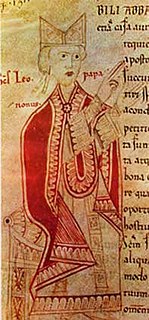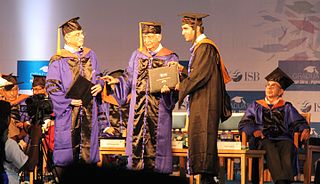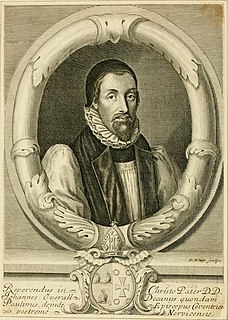
John Wycliffe was an English scholastic philosopher, theologian, biblical translator, reformer, Catholic priest, and a seminary professor at the University of Oxford. He became an influential dissident within the Roman Catholic priesthood during the 14th century and is considered an important predecessor to Protestantism. Wycliffe questioned the privileged status of the clergy which had bolstered their powerful role in England and the luxury and pomp of local parishes and their ceremonies.
Pope Alexander II, born Anselm of Baggio, was the head of the Roman Catholic Church and ruler of the Papal States from 1061 to his death in 1073. Born in Milan, Anselm was deeply involved in the Pataria reform movement. Elected according to the terms of his predecessor's bull, In nomine Domini, Anselm's was the first election by the cardinals without the participation of the people and minor clergy of Rome.

Simony is the act of selling church offices and roles or sacred things. It is named after Simon Magus, who is described in the Acts of the Apostles as having offered two disciples of Jesus payment in exchange for their empowering him to impart the power of the Holy Spirit to anyone on whom he would place his hands. The term extends to other forms of trafficking for money in "spiritual things".

Pope Leo IX, born Bruno of Egisheim-Dagsburg, was the head of the Catholic Church and ruler of the Papal States from 12 February 1049 to his death in 1054. Leo IX is considered to be one of the most historically significant popes of the Middle Ages; he was instrumental in the precipitation of the Great Schism of 1054, considered the turning point in which the Catholic and Eastern Orthodox Churches formally separated. He is venerated as a saint in the Catholic Church.
Theobald of Bec was a Norman archbishop of Canterbury from 1139 to 1161. His exact birth date is unknown. Some time in the late 11th or early 12th century Theobald became a monk at the Abbey of Bec, rising to the position of abbot in 1137. King Stephen of England chose him to be Archbishop of Canterbury in 1138. Canterbury's claim to primacy over the Welsh ecclesiastics was resolved during Theobald's term of office when Pope Eugene III decided in 1148 in Canterbury's favour. Theobald faced challenges to his authority from a subordinate bishop, Henry of Blois, Bishop of Winchester and King Stephen's younger brother, and his relationship with King Stephen was turbulent. On one occasion Stephen forbade him from attending a papal council, but Theobald defied the king, which resulted in the confiscation of his property and temporary exile. Theobald's relations with his cathedral clergy and the monastic houses in his archdiocese were also difficult.
William de Corbeil or William of Corbeil was a medieval Archbishop of Canterbury. Very little is known of William's early life or his family, except that he was born at Corbeil, south of Paris, and that he had two brothers. Educated as a theologian, he taught briefly before serving the bishops of Durham and London as a clerk and subsequently becoming an Augustinian canon. William was elected to the See of Canterbury as a compromise candidate in 1123, the first canon to become an English archbishop. He succeeded Ralph d'Escures who had employed him as a chaplain.
Richard was a medieval Benedictine monk and Archbishop of Canterbury. Employed by Thomas Becket immediately before Becket's death, Richard arranged for Becket to be buried in Canterbury Cathedral and eventually succeeded Becket at Canterbury in a contentious election. Much of Richard's time as archbishop was spent in a dispute with Roger de Pont L'Evêque, the Archbishop of York over the primacy of England, and with St Augustine's Abbey in Canterbury over the archbishop's jurisdiction over the abbey. Richard had better relations with King Henry II of England than Becket had, and was employed by the king on diplomatic affairs. Richard also had the trust of the papacy, and served as a judge for the papacy. Several of his questions to Pope Alexander III were collected into the Decretals, a collection of ecclesiastical laws, and his patronage of canon lawyers did much to advance the study of canon law in England.

The Lambeth Conference is a decennial assembly of bishops of the Anglican Communion convened by the Archbishop of Canterbury. The first such conference took place at Lambeth in 1867.
An ecclesiastical court, also called court Christian or court spiritual, is any of certain courts having jurisdiction mainly in spiritual or religious matters. In the Middle Ages these courts had much wider powers in many areas of Europe than before the development of nation states. They were experts in interpreting canon law, a basis of which was the Corpus Juris Civilis of Justinian which is considered the source of the civil law legal tradition.

A convocation is a group of people formally assembled for a special purpose, mostly ecclesiastical or academic.

The Arches Court, presided over by the Dean of Arches, is an ecclesiastical court of the Church of England covering the Province of Canterbury. Its equivalent in the Province of York is the Chancery Court.
A prolocutor is a chairman of some ecclesiastical assemblies in Anglicanism.
The Lateran councils were ecclesiastical councils or synods of the Catholic Church held at Rome in the Lateran Palace next to the Lateran Basilica. Ranking as a papal cathedral, this became a much-favored place of assembly for ecclesiastical councils both in antiquity and more especially during the Middle Ages.
The General Synod is the tricameral deliberative and legislative organ of the Church of England. The synod was instituted in 1970, replacing the Church Assembly, and is the culmination of a process of rediscovering self-government for the Church of England that had started in the 1850s.
The Submission of the Clergy was a process by which the Catholic Church in England gave up their power to formulate church laws without the King's licence and assent. It was passed first by the Convocation of Canterbury in 1532 and then by the Reformation Parliament in 1534. Along with other Acts passed by the Parliament, it further separated the Church from Rome.
David Staffurth Stancliffe is a retired Church of England bishop. He was Provost of Portsmouth Cathedral from 1982 to 1993, and the Bishop of Salisbury from 1993 to 2010. He is the third generation of his family to serve the ordained ministry.

John Overall (1559–1619) was the 38th bishop of the see of Norwich from 1618 until his death one year later. He had previously served as Bishop of Coventry and Lichfield, as Dean of St Paul's Cathedral from 1601, as Master of Catharine Hall from 1598, and as Regius Professor of Divinity at Cambridge University from 1596. He also served on the Court of High Commission and as a Translator of the King James Version of the Bible.

The Convocations of Canterbury and York are the synodical assemblies of the bishops and clergy of each of the two provinces which comprise the Church of England. Their origins go back to the ecclesiastical reorganisation carried out under Archbishop Theodore of Canterbury (668–90) and the establishment of a separate northern province in 733. Until 1225 the synods were composed entirely of bishops, but during the thirteenth century more and more clergy were cited until by 1283 the membership was established as the bishops, deans, archdeacons and abbots of each province together with one proctor (representative) from each cathedral chapter and two proctors elected by the clergy of each diocese. The main purpose of the convocations was to take counsel for the well-being of the church and to approve canonical legislation, but in practice much time was spent in discussing the amount of tax to be paid to the Crown since the clergy were a separate estate of the realm and refused to be taxed in or through Parliament. Before the end of the nineteenth century, the Convocation of Canterbury, which was numerically very much larger, played the major role and the activity of the Convocation of York was often little more than giving formal approval to the decisions taken by the southern province.
Arles in the south of Roman Gaul hosted several councils or synods referred to as Concilium Arelatense in the history of the early Christian church.
Dr Richard Gwent was a senior ecclesiastical jurist, pluralist cleric and administrator through the period of the Dissolution of the Monasteries under Henry VIII. Of south Welsh origins, as a Doctor of both laws in the University of Oxford he rose swiftly to become Dean of the Arches and Archdeacon of London and of Brecon, and later of Huntingdon. He became an important figure in the operations of Thomas Cromwell, was a witness to Thomas Cranmer's private protestation on becoming Archbishop of Canterbury, and was Cranmer's Commissary and legal draftsman. He was an advocate on behalf of Katherine of Aragon in the proceedings against her, and helped to deliver the decree of annulment against Anne of Cleves.








